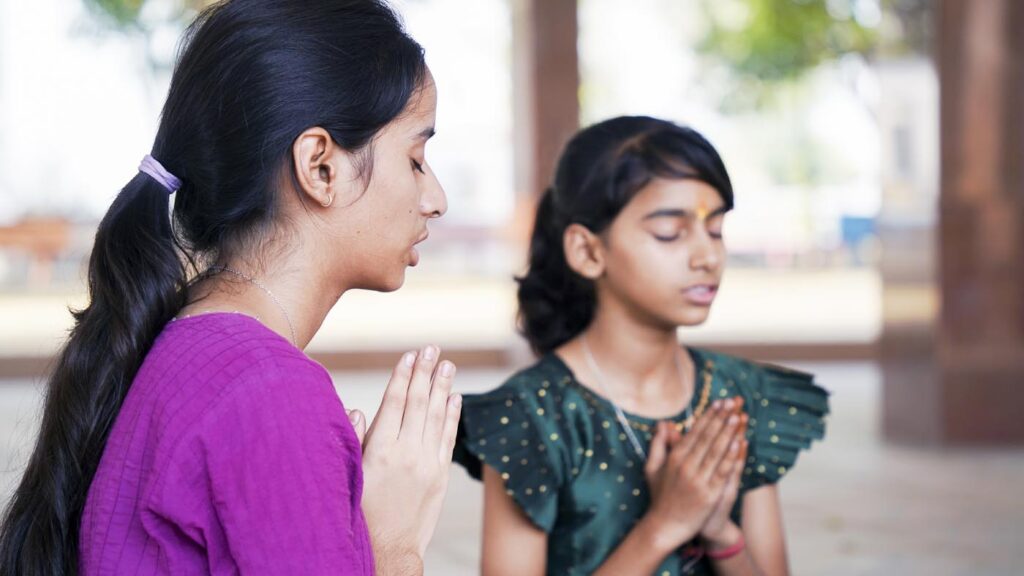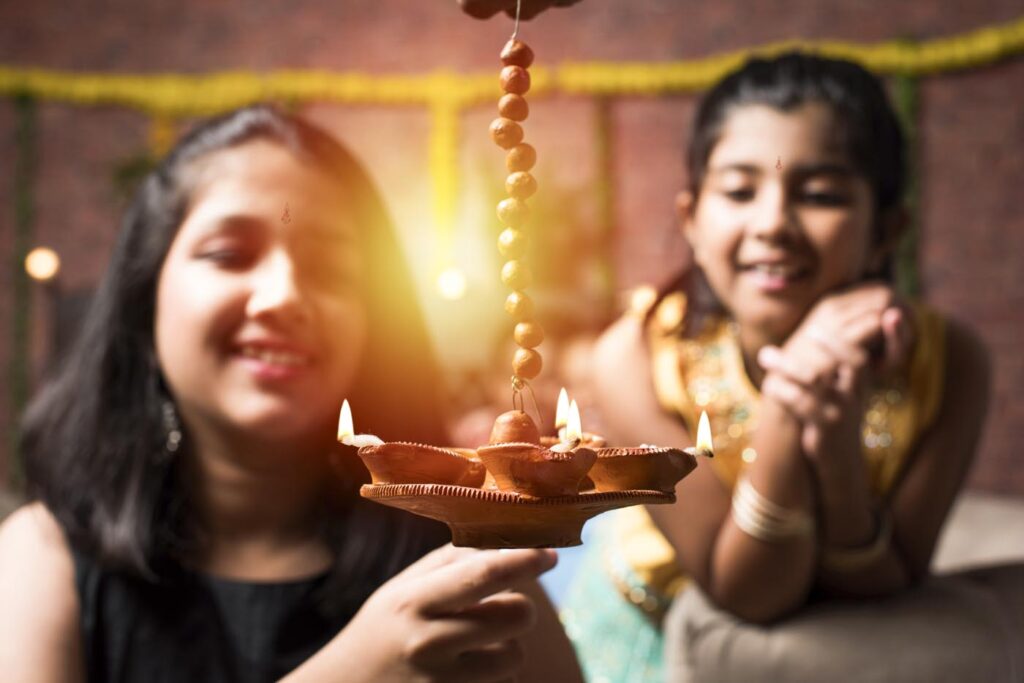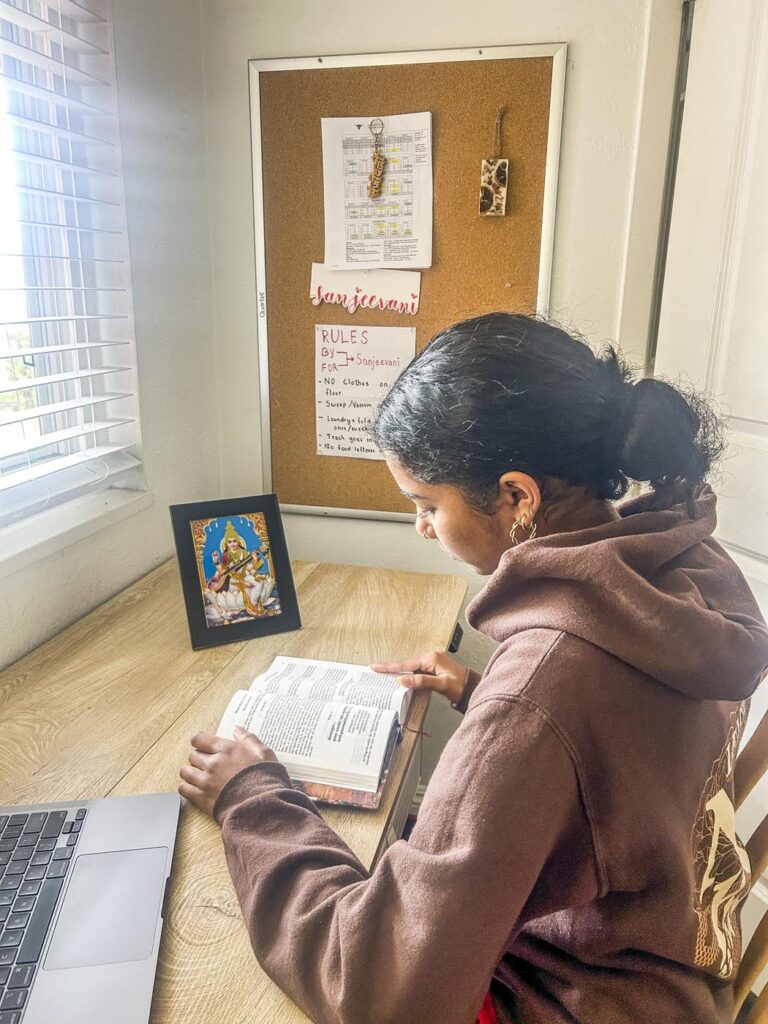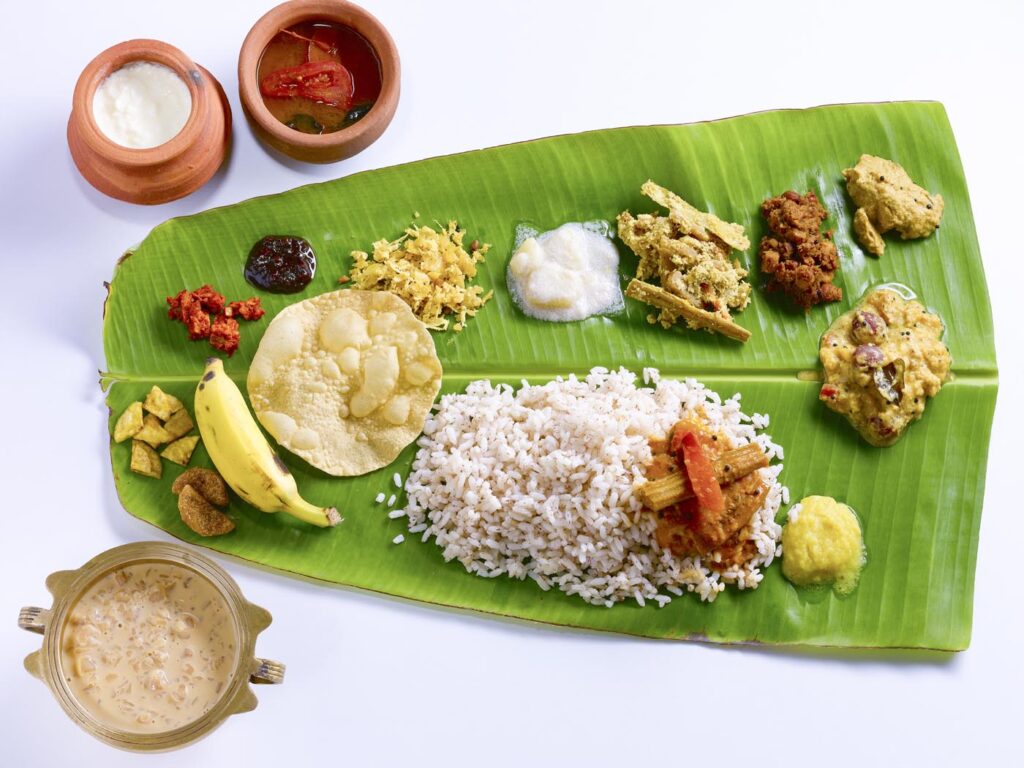Yes, we teens can make spiritual practices work in our lives
By Sanjeevani Dedge and Mugdha Shinde
High school is an exciting but often overwhelming time. With a packed schedule full of schoolwork, sports, extracurriculars and social activities, it’s easy for students to lose touch with their spiritual practices. As high school juniors, we often find that religious rituals get pushed aside due to academic and personal commitments. But staying connected to our Hindu faith doesn’t have to be an all-or-nothing commitment. Through small adjustments and mindful practices, it’s possible to nurture our spirituality, even on the busiest days. In this article, we’ll explore simple strategies for incorporating Hinduism into your daily routine, helping you maintain a strong spiritual foundation while balancing academics and extracurriculars. From quick mantras when you wake up, to giving volunteer hours to temples, here are practical strategies that students can fit into their schedule.
A. Religious Rituals

1) Mantras: The first tip is to say a mantra in the morning when you wake up, and one at night before going to sleep. This takes less than 30 seconds each, and is easy to make a habit of. We recommend students chant “Karaagre Vasate Lakshmi” or “Samudra Vasane Devi” once they wake up, and “Ramam Skandham” when they go to sleep.

“Karaagre Vasate Lakshmi” is originally from the Padma Purana. In transliteration it is: “kara-agre vasate lakssmiih kara-madhye sarasvatii; kara-muule tu govindah prabhaate kara-darshanam.” It means, “At the top of the palm dwells Lakshmi, and at the middle of the palm dwells Saraswati, at the bottom of the palm dwells Govinda; therefore one should look at one’s palms in the early morning and contemplate on them.”
The second morning mantra, “Samudra Vasane Devi,” is originally part of a hymn dedicated to Goddess Ganga, which appears in the Mahabharata: “Samudra-vasane devi parvata-stana-mandale; vishnu-patni namas-tubhyam paada-sparsham kshamasva-me.” It means, “O! Mother Earth, who has the ocean as Her clothes, mountains and forests as Her body, who is the wife of Lord Vishnu, I bow to you. Please, forgive me for stepping on You with my feet.”Both poems have beautiful meanings, and by understanding each and saying them first thing in the morning, you can get off to a great start for your day.
Similarly, reciting “Ramam Skandham” before you go to sleep can calm you down since it is a prayer for peaceful sleep without disturbing dreams. This can also be a good time to take just a few moments to express gratitude to God, and for the lessons you have learned.
This verse from the Bhagavad Gita reads: “Ramam skandham hanumantam vainateyam vrkodaram; shayane yah smarennityam dusvapna-stasyanashyati.” It means, “Whoever remembers Hanuman, Rama, Skanda, Garuda and Bhima every night before sleep will be free of bad dreams and enjoy peaceful sleep.”
Ever since fourth grade, I [Mugdha] have strictly said this prayer every single night, because I have told myself that I should do at least one Hindu thing without fail everyday if I am not able to do puja. Even at sleepovers or school trips, I recite the prayer in my mind before saying, “Shubha ratri, shubha swapna,” which in Marathi means “May you have a good night, may you have good dreams.” This little tradition has helped me stay connected to my religion for over half a decade now.

2) Lighting a Lamp: An additional morning ritual to expand your connection to Hinduism is lighting a diya, or small oil lamp. This is a relatively quick action, yet it holds the great significance of bringing light into the world, and positivity for the day ahead. It is not a whole puja, but it is perfect for those of us with only a few minutes to spare in the mornings.

B. Personal Practices

3) Background Music: Putting on music in the background is an easy practice that can have a big impact. I [Sanjeevani] will give a personal example: I really wanted to learn “Hanuman Chalisa,” because when we sang it in our local Hindu organization during bhajan meetings, I never knew the words. Determined to learn, I told my mom, and she suggested playing it in the background while I get ready in the morning. And over a few months, I found myself being able to sing along to parts of the bhajan. I also noticed that just having the music playing in the background improved my mood.

4) Reading During Breaks: Reading is a great way to learn about your religion, but you may feel like you don’t have enough time. So, the fourth tip is to carry a book, such as a modern explanation of the Gita, or a Vedas for kids, in your backpack, or download an audiobook onto your phone. While finishing a whole book may seem daunting, it’s a lot easier if you think of it as five minutes of reading or listening per day. And you can easily find five minutes while being driven anywhere, between classes, while you walk home, while doing chores or even during study breaks.


5) Jewelry & Dress: Jewelry can be a meaningful way to incorporate Hinduism in daily life. One common religious accessory is a necklace with an Om pendant. These are typically made of gold or silver and can easily be found online. We’ve also seen many people wearing necklaces with their name in Devanagari or in their mother tongue. Websites such as “Brown Girl Gang” offer these necklaces in a variety of Indian languages, including Assamese, Tamil, Marathi, Kashmiri, Oriya and more. Such necklaces are beautiful ornaments and spiritual reminders. Similarly, tattoos or piercings can provide a permanent reminder of faith and constant guidance. Hindu tattoos are usually of a symbol, mantra or Deity such as Siva’s trishul or Ganesha. This past summer in India, I [Sanjeevani] got my first tattoo—an Om on my left hand—which brings me joy every time I see it. Many women in my family including my grandma have religious tattoos called gondhan in Marathi. Nose piercings are also very important in many Indian cultures.
A great way to incorporate Hinduism in your daily life is dressing ethnically. Wearing a bindi everyday is a small gesture that shows you are connected to your culture, even when in public. For boys, wearing a rakhi wrist band achieves the same result. In fact, my [Mugdha’s] brother, Aaditya Shinde, wears a rakhi for the whole year after Raksha Bandhan. When asked how this helps him feel connected to Hinduism, he said, “It’s a good reminder on my arm at all times about my relationship with my sister, without being something out of the ordinary or too showy.” Ethnic wear is especially important during the festivals. Aaditya recommends wearing traditional clothes to school or work during big festivals such as Diwali.

6) Diet: Shifting to a vegetarian diet is a wonderful way to practice nonviolence (ahimsa), which is a key principle in Hinduism. To make the transition smooth, you can start by avoiding meat on certain days and gradually increasing your amount of vegetarian meals. You can also find vegetarian alternatives for your favorite dishes and explore new recipes to keep things interesting. I [Sanjeevani again] used to eat meat, but about five years ago, I switched to being vegetarian—and I couldn’t be happier with the change.

C. Community Activities

7) Volunteer/Visiting Temples: Our next tip is to volunteer at temples. Not only does it make you feel connected with your community and improve your social skills, but in certain cases you can actually get volunteer credit for the hours. This is especially significant for students, because many high schools, and even clubs, require a certain number of volunteer hours per semester, so this is a great way to meet that criteria. You just have to make sure that the volunteering you do benefits the whole community, or else it won’t count. For example, if the temple hosts a food drive or is giving out free prasad that benefits everyone, then hours spent setting up, collecting/preparing or serving food would count.

8) Youth Group: Another tip is to join a Hindu youth group. This can mean joining a club at school or an outside Hindu organization. Make sure to be an active member and regularly attend the meetings and events. This can also be a great place to find like-minded friends/peers who share similar values and interests. You will find a supportive environment where you can share experiences, celebrate festivals together and create lasting friendships. We both started a Hindu club at our respective schools this year, and have noticed the positive difference having a Hindu community at school has made in our life.

9) Cultural Activities: A powerful way to maintain your faith, is to enroll in cultural classes that interest you. This can mean classical music like Carnatic singing, learning the tabla, classical dance such as Bharatanatyam or Odissi, or even learning a language, such as Sanskrit or your mother tongue. These classes typically take only one to two hours per week, yet they can teach you a lot about your culture. For example, Revati Tambe, a junior in high school, when asked about her personal religious practice, explains, “While I don’t spend time on prayers or puja every day, I stay connected to my religion and culture through Hindustani classical singing and tabla. Every day, I do about 30-60 minutes of practice, which not only keeps me rooted in my traditions but also helps me relax and clear my mind of stressful thoughts.”
This tip is for anyone seeking more time-efficient ways to stay connected to Hinduism beyond daily puja. However, we would stress that these activities are not a replacement for visiting temples or conducting extensive puja when one has enough time. As Revati later mentioned, “I think it is important to visit the temple when I have time, because it helps me feel connected not just to my religion but to my culture as a whole. It’s nice seeing other families worshiping at the temple, and there’s also this sense of peace I get.” Visiting the temple is an irreplaceable experience for Revati and for everyone in general.

10) Performances: If you are talented at singing, as Revati is, or at another cultural activity, such as dance or playing a traditional instrument, school performances are great opportunities to practice and showcase your Hindu culture. At my [Mugdha’s] school, we have Multicultural Week, Fall Family Night, and Friday rallies, all great stages for a Hindu performance. In addition to the actual performance, the practice and preparation leading up to it will help you stay close to Hinduism on a daily basis.


11) Mobile App: There is a free mobile app, called “Spiritual Workout,” that leads you through a short daily religious check in. It is a great tool for Hindus in high school or college who have a busy schedule, as well as for people of all ages who want a place to start with their daily religious activities. It helps you participating in a religious activity for at least ten minutes a day.
Conclusion
Integrating Hinduism and its practices into your life as a high school student is not only possible, but will help you thrive. By following these small tips and tricks you can create a fulfilling balance between your spiritual journey and academic commitments.
About The Author

Mugdha Shinde, 16, is an 11th-grade student in the San Francisco Bay Area. She plays trombone in her school’s band and enjoys cooking and baking. mugdha.shinde29@gmail.com.

Sanjeevani Dedge, 16, lives in San Jose. As an 11th-grade student at Leigh High School, she is president of the Hindu Club and an active member of the student government. In her free time, she enjoys painting and exploring her passion for writing. sanjeevanisdedge@gmail.com
